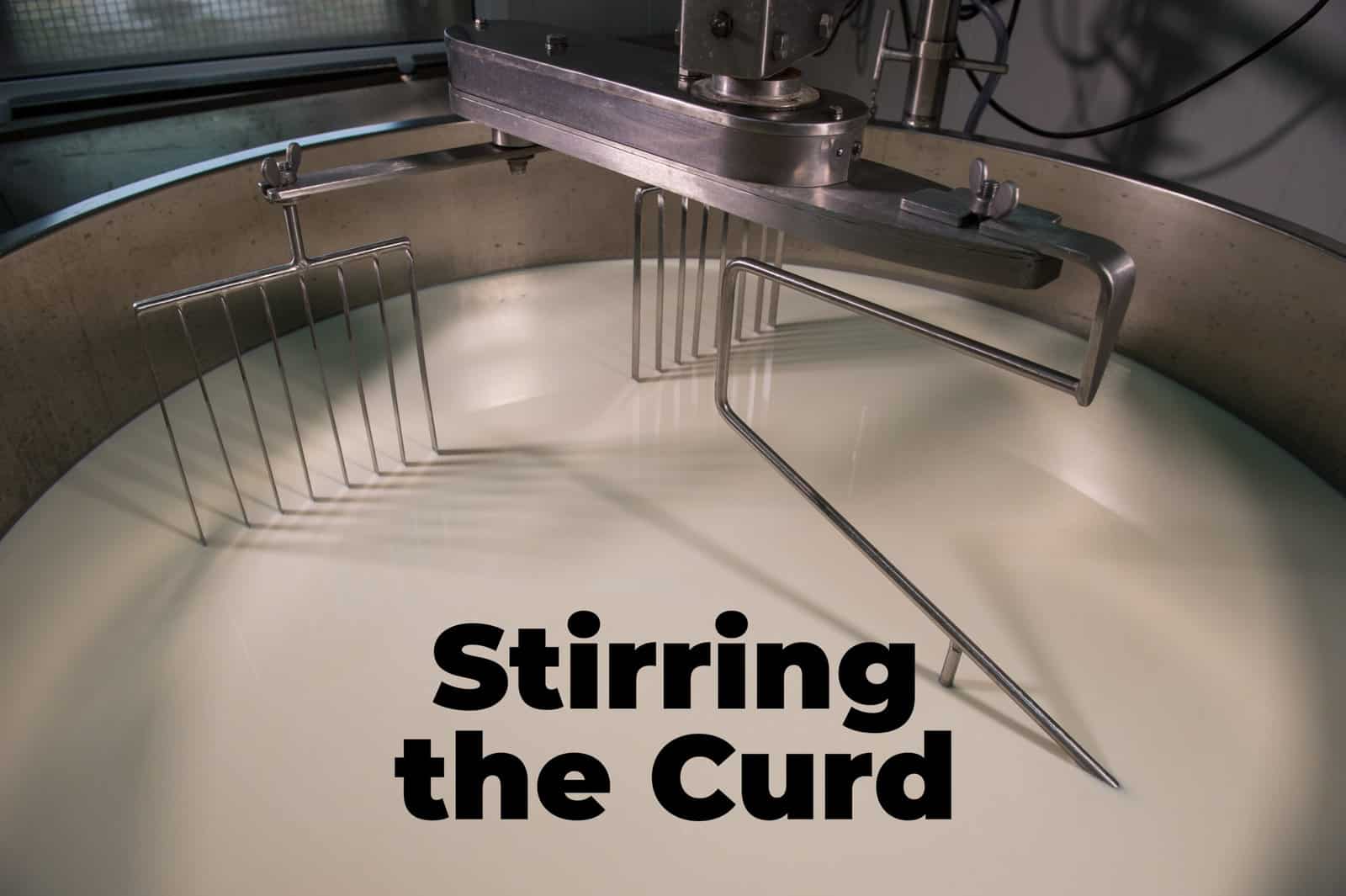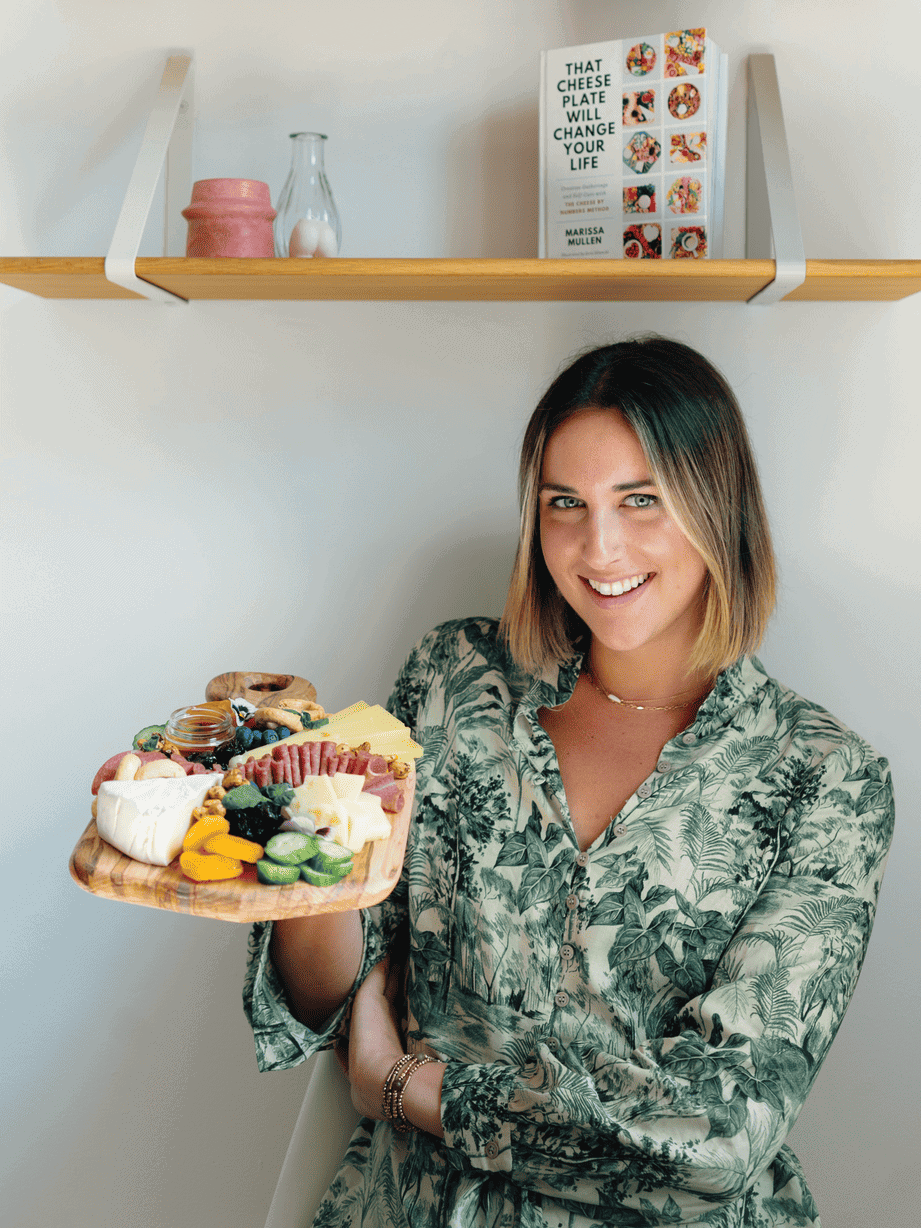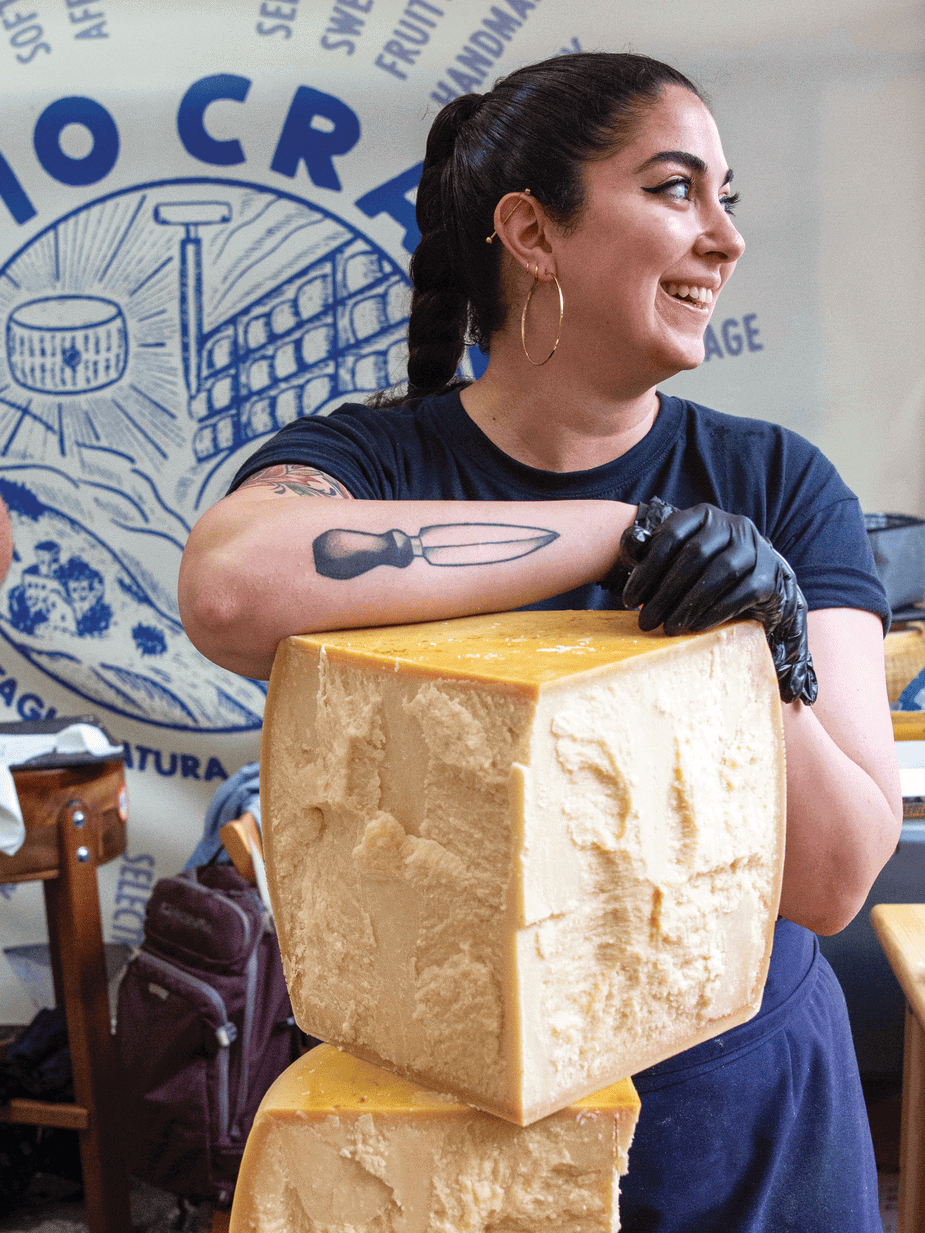
In an era defined by pervasive social media presence, “influencers” have emerged as powerful agents in shaping our choices. These individuals, who have harnessed the power of digital platforms to amass large, devoted followings, are arguably able to sway our preferences and purchasing decisions because of an established trust. In this installment of Stirring the Curd, we asked two prominent cheese influencers—Marissa Mullen and Emilia D’Albero—how they view the role of influencers in the cheese industry.
Marissa Mullen, the creative force behind That Cheese Plate, boasts a significant social media presence with over 1 million followers across platforms. As a bestselling author, entrepreneur, and food stylist, she has established herself as a leading authority in the world of cheese, captivating a global audience with her exquisite creations and innovative “Cheese By Numbers” method.

Culture Media (CM): What role does the influencer play in the cheese industry?
Marissa Mullen (MM): I believe that my personal role as a cheese influencer is to raise awareness for all that cheese can be—whether that’s styled on a plate with pairings, highlighted behind the scenes at a dairy farm, weaved into a recipe, or enjoyed as a form of self-care. I love to showcase how cheese is a unifying food, bringing together many different types of people from all backgrounds.
I also love to encourage creativity with cheese, teaching people useful skills in the world of food-styling and serving. The ‘cheese influencer’ has made cheese enjoyment accessible to many, helping boost the awareness of dairy domestically and internationally.
CM: What was your primary vision when you started “That Cheese Plate”, and how has it evolved over time?
MM: I started That Cheese Plate back in 2013 as a centralized location for cheese plate inspiration. My primary vision was to create an online space where people could discover unique food styling ideas while learning about different cheeses and cheese pairings. I’ve always loved cheese and built the page based on my passion for the art and entertainment around the cheese plate itself. Over the past 10 years, my account has evolved into an engaged online community with two cookbooks, an educational platform, a content creation hub, and an event production company.
I created the “Cheese By Numbers” method, which is my step-by-step board building technique, I teach “That Cheese Class,” a 2-hour board building class with cheese education, cheese pairing techniques, and food photography tips, and I provide recipe inspiration, travel tips, and highlight different cheeses from around the world on my social platforms.
CM: How do you balance entertainment and education on your platform? What’s the role of the digital space in making cheese education more accessible?
MM: There’s a balance between entertainment and education on the internet, the key is to keep viewers (with extremely short attention spans) interested, while trying to share the most amount of information possible.
I understand that I have a big influence in the space, so I try to provide helpful tips when I can. I will say however, in recent years I’ve kept my cheese brands pretty generic, leaving the actual choice up to the consumer. As much as I want to feature amazing small-batch, domestic cheese, it’s not the most accessible to people across the country.
Trying to exist between the Trader Joe’s and the Murray’s Cheese shoppers is something that I think is important so everyone can feel included. When I travel, I love to feature local cheeses in the area, which I believe is an organic and educational tie-in.
CM: How has the cheese industry responded to your influence and the rise of cheese influencers in general?
MM: I can’t speak on behalf of other cheese influencers because I don’t know their experience, but the cheese industry as a whole has been nothing but supportive of That Cheese Plate. So many amazing cheesemongers and professionals in the cheese space have given me advice and guidance over the years and I’m always open to learning more every day. I try my best to be accessible online to the folks who can’t afford expensive cheese, while also supporting many local, artisanal, and sustainable dairy farmers in my cookbooks and classes. It’s been an honor to feel included in events like the Cheesemonger Invitational, the Art of Cheese Festival in Wisconsin, and seeing my books in cheese shops across the country.
CM: What trends do you foresee in the cheese world, and how do you think digital platforms will influence these trends?
MM: It’s hard to say, trends are moving so quickly these days due to the presence of TikTok. Recent food trends like “fried feta eggs” and “girl dinner” might become insignificant in the next few months when a new trend begins. It’s difficult to predict. However, I think the rise of dinner parties are still prevalent amongst Millennials and Gen Z, who tend to influence the space. I see a fair share of curated and themed events which always tend to feature a cheese plate of some kind.
In terms of styling and design, I’m seeing that less is more these days. I was never a supporter of the ‘put anything on a board and call it charcuterie’ moment, so I do appreciate that recent cheese plates are reflecting more of a European style, going back to the roots of French and Italian serving techniques.
Emilia D’Albero, currently the sales and marketing manager at Formaticum, is an American Cheese Society Certified Cheese Professional, as well as a Cheesemonger Invitational finalist and winner. She uses her TikTok account, @punkrockparmigiano, as a platform to educate her more than 184K followers.

CM: What role does the influencer play in the cheese industry?
Emilia D’Albero (ED): The digital space has expanded the reach of cheesemongers and educators in an unimaginable way, but it has also expanded our responsibility to our customers and also to our producers. We must use the privilege of this type of platform to celebrate the work that cheesemakers, affineurs, and everyone in between has been doing for centuries and help foster appreciation for these products to help keep the cheesemaking tradition alive in this new era of mass-produced commodity cheese. I’m also always very conscious of the fact that cheese can be intimidating for many consumers and I believe it is the content creator’s responsibility to make sure all their viewers feel welcome. Every product I promote on my account is something I personally endorse and consume, and that has a place on my counter. The TikTok account is an extension of the work that I do every day in the cheese industry and I’m privileged and grateful to have been able to share that with the 35+ million people who have watched my videos.
CM: What was your primary vision when you started “@punkrockparmigiano”, and how has it evolved over time?
ED: I downloaded TikTok during the pandemic, like so many of us, and quickly realized that there was a lack of cheese content on the platform. I was a cheese buyer in a grocery store at the time, and I originally started by posting videos of me opening wheels of cheese to different songs (hence the username) and never expected my videos to garner that kind of attention. The comment sections on my first viral videos made me realize that the app was in desperate need of real educational cheese content, so I pivoted to including voiceovers on the videos where I talked about the cheese and producer, and included some entry-level cheese facts as I was targeting the consumer audience with those videos.
Eventually “CheeseTok” took off and more and more shops and mongers began posting their own videos, and I realized that there was an opportunity for me to provide mongers with education as well. I have a “Monger Tips” series where I show techniques like how to break down a Parmigiano wheel into clean retail cuts, how to wrap different shapes of cheese in paper and plastic, how to open large format Alpines with a double handle wire, how to properly cut a wedge of Emmentaler AOP—just to name a few. The app has become a way for me to reach the cheese community beyond the NYC area and help more mongers improve their skills and knowledge. Even if one of my videos technically “flops”, it was worth my time to make it if one monger learns something from it.
My favorite style of video that I’ve been making lately is what I call the “Life Cycle of a Cheese” where I visit producers and show the farm and the process of making/aging the cheese, and then I show myself opening the wheel behind the counter. I’ve been lucky enough to visit producers from Wisconsin to Switzerland and highlight some of my personal favorite cheeses and cheese people. Visiting producers is something that not every monger gets to do, and in my experience, it creates an emotional connection with the product that fosters a greater understanding and appreciation for the time and labor it takes to make our favorite cheeses and get it to our counters. Helping other mongers find that understanding and appreciation is the goal of those videos.
Creating all these different types of content has been a great creative challenge for me to learn new skills and think of more ways to share my experiences with the community! My goal is to share as much knowledge as possible with as many people as possible and I’m grateful for the support that has given me a platform to do that.
CM: How do you balance entertainment and education on your platform? What’s the role of the digital space in making cheese education more accessible?
ED: While my videos are almost entirely educational, I do like to jump on the occasional fun trend! But I always make it cheese-related somehow. I’ve also had to learn what catches people’s attention and what keeps it throughout the video—i.e. changing shot angles, text on the screen, voiceover vs. music, etc. It’s been a fun little crash course in content creation for me.
The digital space has expanded our reach in an unimaginable way. It still blows my mind that over 35 million people have watched me open wheels of cheese! I’m always very conscious of the fact that cheese can be intimidating for many people, and I want everyone who watches my videos to feel welcome on my platform. Because I know how many people watch my videos and rely on me to convey correct information, it’s very important to me that I research and fact check every video. I consult my cheese library and speak directly with producers and importers. A 45 second video can take me 2 to 3 hours (or more) to research and edit! It’s incredibly important to me to be conscious of the impact that my videos can have, and therefore I am responsible for making sure I am not spreading misinformation for views.
CM: How has the cheese industry responded to your influence and the rise of cheese influencers in general?
ED: The cheese industry has been overwhelmingly supportive of my content in a way that I could not have ever imagined. I have been given so many lifechanging travel and work opportunities partly because of this account, including my current job, for which I am so very grateful. When other mongers recognize me at events and tell me that they watch my videos and have learned new things from them, that is what makes all my work worth it; it doesn’t matter what my engagement rate is. I’ve also made so many new friends because of my videos. I feel like at every event I attend, I meet someone in person for the first time after having been internet friends for so long.
Let me be very clear that I do not do any of this for the spotlight, and in fact, I don’t really like the attention that I’ve gotten. I’m much more of a “behind-the-scenes” person who finds satisfaction in doing the work to uplift other members of this community. I do not refer to myself as a “cheese influencer,” as I believe there is a significant difference between influencers and cheese professionals who are also content creators. I am not a food stylist or a videographer—my full-time job (and main focus) is and always has been cheesemongering, cheese buying, and cheese education. I choose to use my platform as an extension of those roles, and every product I promote on my account is something I personally endorse and consume, and that has a place on my counter. Cheesemongers have been “influencing” each other’s work since before Instagram existed, and that constant exchange of knowledge and strong sense of community is why I love the cheese industry so much.
In the midst of the pandemic and how it was affecting our industry, I felt obligated to help in any way I could to help producers move cheese and also get consumers familiar with and excited about it! At its core, cheesemongering is about stewardship and storytelling, and my TikTok account is a way for me to amplify the work that we do behind our counters every day to honor the work done by farmers, cheesemakers, affineurs, distributors, and every person in between at every level of the supply chain. We wouldn’t be here without them, and they are the people who deserve the spotlight.
CM: Have you noticed any shifts in consumer behavior or preferences due to the influence of digital cheese influencers like yourself?
ED: Absolutely! The pandemic made home cooking a necessity, and cheese videos seemed to explode in popularity. Managing a specialty cheese counter in a grocery store during the pandemic allowed me to see that firsthand. I noticed people developing a new appreciation for “real” cheese and even seeking out specific cheeses that they had seen in videos. More customers wanted to have conversations with my mongers, and we cultivated so many relationships with new regulars who would come back every few days to try something new. I met people who had come from all over New York City and even New Jersey to buy cheese from our little counter in Brooklyn. I can’t tell you how much that warmed my heart in the middle of an otherwise harrowing experience.
One year I accidentally sold my entire stock of Brabander Reserve, Rogue River Blue, and Rush Creek Reserve literally overnight because one of my videos went viral, and we actually had to close our mail order site until we had sorted through all the orders. It took me and three other mongers three full days to cut, wrap, and package all the cheese, charcuterie, and even butter that had been ordered (special shoutout to Caroline Hesse for helping us with that!) We affectionately called it “Cheesepocalypse” and when the “oh no! It’s sold out!” comments started rolling in on the video, I was able to direct the commenters to other small shops and businesses that could benefit from the hype surrounding these cheeses.
Suddenly needing to cook for themselves every day not only helped consumers better appreciate local and artisan food and understand the importance of supporting small businesses, but also allowed them to discover how comforting and healing it can be to allow yourself “a little treat” like cheese and charcuterie on any old day when the world outside is full of uncertainty. A piece of good cheese makes every day a little more special. People really needed that extra support during the height of the pandemic, and it made me so happy to be able to provide that for the community both in Brooklyn and wherever my followers reside. While I may not be making videos as frequently these days, I look fondly upon my brief time in the TikTok spotlight and am grateful to have had the chance to make even a small difference on a small screen.



